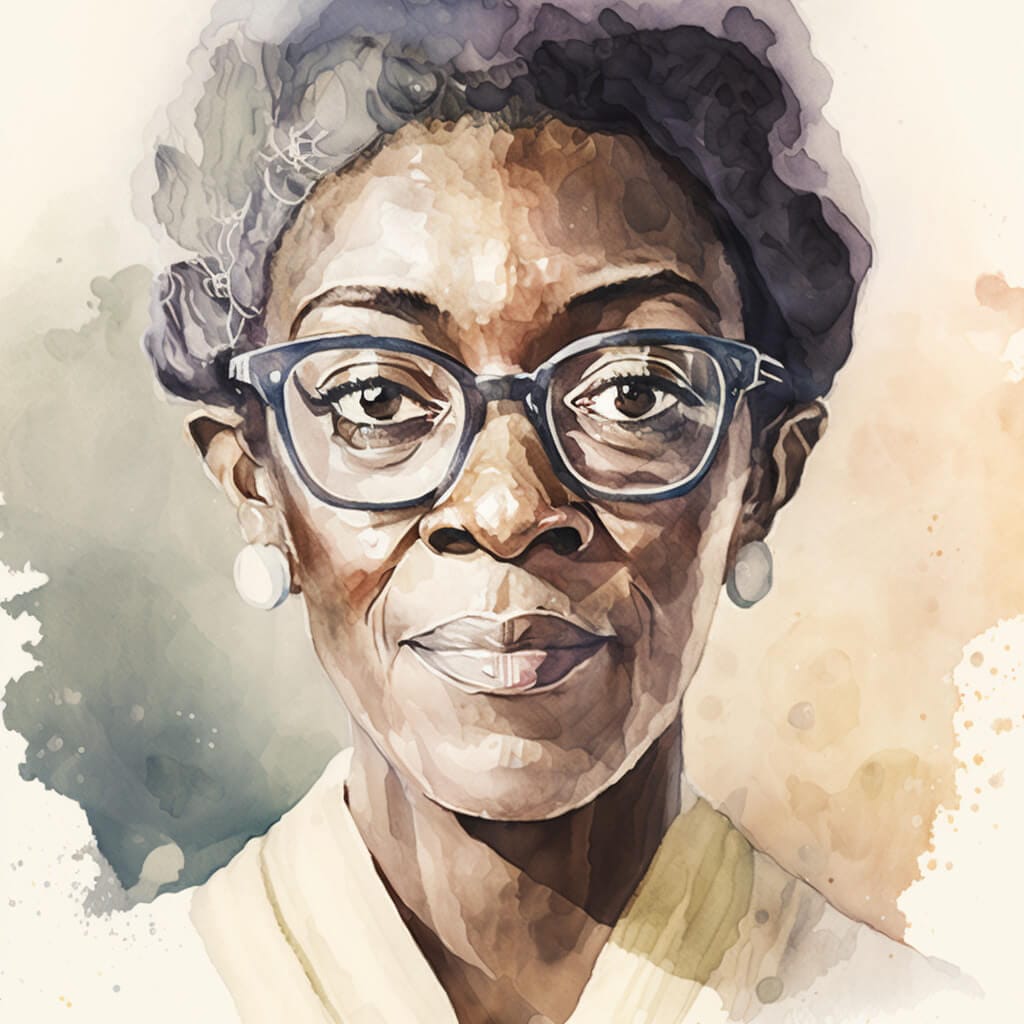Gwendolyn Brooks was the first African-American to win a Pulitzer Prize, which she won for ‘Annie Allen’ in 1950. She also took on the role of Poet Laureate of the United States and was awarded the National Medal of Arts. However, the accolades did not stop there, as she earned over fifty honorary degrees during her literary career. She is remembered for writing about the lives of ordinary Black men and women growing up in similar neighborhoods to her own in Chicago. Brooks wrote an autobiography in 1972, documenting her incredible life, which was part of her major prose works.
Life Facts
- Gwendolyn Brooks was born in Topeka, Kansas, in 1917.
- Brooks’ first collection, ‘A Street in Bronzeville,’ was published in 1945 by Harper & Brothers.
- In 1968 Brooks was appointed the Poet Laureate of Illinois.
- In 1985 she was made the Consultant in Poetry to the Library of Congress.
- Gwendolyn Brooks died in December of 2000 at the age of eighty-three.
Interesting Facts
- She was also inducted into the American Academy of Arts and Letters.
- Langston Hughes and James Weldon Johnson enjoyed her poetry.
- Brooks was the first African American to receive a Pulitzer Prize for Poetry.
- She also received the ‘Poetry‘ magazines Eunice Tietjens Prize.
- After her death, one of her childhood high schools was renamed in her memory.
Famous Poems
- ‘We Real Cool’ is likely Brooks’ most studied poem. It is included in many school syllabuses around the world. The poem describes the lives of seven pool players who lurk in the night, don’t go to school, and plan on dying soon. The poem is remembered for its unusual syntax and style. Brooks uses alliterative phrases like “Lurk late” and “Sing sin” as well as a great deal of internal rhyme in this short piece.
- ‘Primer for Blacks’ is another quite well-known poem. In it, Brooks discusses the necessity of coming to terms with and loving one’s identity. Specifically, she is talking about Black heritage and culture. She, or at least the speaker she’s channeling, believes that this is the only way that the Black community will have a unified, optimistic future.
- ‘the mother’ is a moving, memorable poem in which a woman discusses the abortions that she’s had and the regret she feels about them. The “mother” talks the reader through the losses she’s suffered and wonders about the people her children would’ve grown up into.
- ‘The Bean Eaters’ is another short poem on this list. It discusses the lives of an older, poor couple who have very few possessions. The ones they do have, which the poet describes briefly, appear worthless and useless. They’re living out the last years of their lives, forgotten, in a rented room.
- ‘kitchenette building’ is similar to ‘The Bean Eaters’ in that it focuses on an impoverished community. This time, the poet is focused on the tiny, one-room apartments in Chicago in the early to mid-1900s. These apartments are used to represent the racial wealth gap in the city and also to discuss how impossible it is to maintain “dreams” in that situation.
- ‘Riot‘ illustrates the dissonance that exists between the privileged and those who are driven to desperation to riot. Racism is at the center of this poem, offering a glimpse into the backward and selfish thinking that those who are privileged use to justify the suffering of other people.
Explore more Gwendolyn Brooks poems.
Early Life
Gwendolyn Brooks was born in Topeka, Kansas, on June 7, 1917. Her parents, David Anderson Brooks and Keziah Corinne, were a janitor and school teacher, respectively. Brooks was their first child. When she was only six years old, the family moved to Chicago. She would live there for the rest of her life. As a young girl, she attended Forestville Elementary School on the South Side of the city. Brooks was thirteen years old when she published her first poem, ‘Eventide.’ It appeared in American Childhood. She went on to an integrated, fairly prestigious high school called Hyde Park. Before graduating, she moved between two more schools, Wendell Phillips High and Englewood High.
By the time she was seventeen, her work was frequently appearing in the Chicago Defender, a paper aimed primarily at the African American population of the city. By being such a regular contributor, she was able to push her work out to her audience. It is recorded that by this point in her life, Brooks had written somewhere around 75 poems. They ranged from ballads to sonnets and even work in free verse, inspired by the blues.
After high school, she took part in a two-year program at Woodrow Wilson Junior College. Then went on to work for the National Association for the Advancement of Colored People or the NAACP. During this time period, she attended poetry workshops and did everything she could to develop her writing.
Her parents were very supportive of her throughout her life and understood that she did not want to enter into a four-year college program. It was also around this time period that she married Henry Lowington Blakely, Jr. They had two children together. Brooks would outlive him by only four years.
Literary Career
Before long, Brooks was receiving positive feedback from writers such as James Weldon Johnson and Langston Hughes. Her work during this period was very focused on the experience of Blacks within urban Chicago. In 1944 two of her poems were published in Poetry magazine’s November issue. This was a goal she had been striving for since she was a young girl.
Brooks’ first collection, ‘A Street in Bronzeville,’ was published in 1945 by Harper & Brothers. The book was set in an area of Chicago’s South Side, a place known well by Brooks. It was received very well, and a number of very positive reviews were published in regard to her style. The following year saw Brooks receive her first Guggenheim Fellowship. Her burgeoning career was highlighted in Mademoiselle magazine. The next volume of poetry, ‘Annie Allen,’ followed in 1949. It was focused on the life experiences of a young Black girl growing up in the same areas in which Brooks lived. The work was awarded the Pulitzer Prize for poetry the next year. It also received the Poetry magazines Eunice Tietjens Prize.
A few years later, Brooks’ only narrative book was published. It came in the form of 34 individual vignettes and was titled ‘Maud Martha.’ Her first novel was concerned with the everyday life of a black woman and the doubts that plagued her. She suffered from the preconceived, prejudicial judgments of everyone in her life.
Brooks created a number of books for children also, adding to her already prolific output. In 1956 she released ‘Bronzeville Boys and Girls.’
From 1967 onwards, Brooks started getting involved with the Black Arts Movement after she went to a literary conference at Fisk University, attended by Amiri Baraka, that inspired her to use her voice to make a change.
Some of Brooks’ most notable collections, released from the 1960s onwards, are:
- Riot (1969)
- Family Pictures (1970)
- Aloneness (1971)
- Aurora (1972)
- Beckonings (1975)
Growing Reputation and Fame
In 1968 Brooks was appointed the Poet Laureate of the State of Illinois. She held this position for the next thirty-two years until her death. This was also the year she published one of her most well-known works, ‘In the Mecca.’ The volume was nominated for the National Book Award for Poetry. In general, the collection proved that Brooks was becoming more and more concerned about social problems in her city.
In the 1970s, Brooks left her publisher, Harper & Row, and began taking her work to grow Black publishing companies. These included Broadside press which went on to publish at least six works over the decade. She also edited works for these presses.
The following years saw her win the Anisfield-Wold Book Award and the Shelley Memorial Award of the Poetry Society of America. She was also inducted into the American Academy of Arts and Letters. In 1972 an autobiographical account of Brooks’ life, Report From Part One, was released. It included interviews, photographs, and musings from her life. The follow-up, Report From Part Two, wasn’t released until she was almost eighty years old.
In 1985 she was made the Consultant in Poetry to the Library of Congress, a position better known as Poet Laureate of the United States. In 1989, she was celebrated by the National Endowment for the Arts in the form of a lifetime achievement award.
Brooks was known to engage in mentoring many young poets throughout her life. This focus on giving back helped propel the youth arts movement and, in particular, the Black Arts Movement.
Death
Gwendolyn Brooks died in December of 2000 at the age of eighty-three. After her death, one of her childhood high schools was renamed in her memory, and Western Illinois University’s Gwendolyn Brooks Center for African-American Literature was founded.
Influence from Other Poets
Gwendolyn Brooks was notably influenced by writers such as Paul Laurence Dunbar, Langston Hughes, James Weldon Johnson, and Richard Wright.
FAQs
Arguably, Gwendolyn Brooks’ most famous poem is her epic, book-length work ‘Annie Allen,’ which was released in 1949. The masterpiece won her the Pulitzer Prize a year later, in 1950. Her triumph was groundbreaking for many reasons, but not least, she became the first African-American to win the prize. Brooks also wrote many other poems that were critically acclaimed.
Gwendolyn Brooks was a celebrated poet, ending her career as a highly decorated writer. She won a number of awards throughout her career, but the pinnacle was her Pulitzer Prize win in 1950 for her work ‘Annie Allen.’ Brooks was made the Poet Laureate of the State of Illinois and was brought into the Library of Congress as a poetry consultant. She made history, becoming the first Black woman to take the role.
Yes, Gwendolyn Brooks had two children during her life. She had a son called Henry Lowington Blakely III and a daughter called Nora Brooks Blakely.
Gwendolyn Brooks was married to Henry Lowington Blakely, Jr. from 1939 until his death in 1996.
Gwendolyn Brooks died of cancer in 2000 at the age of 83 years old. Her legacy continues as she pushed the boundaries of what was possible for black poets in the 20th century.


